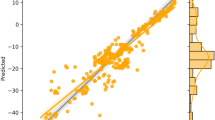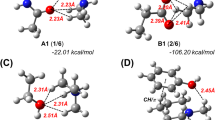Abstract
We introduce a new method to estimate the importance of hydrogen-bonding sitepoints in the binding site of a protein as part of a structure-based design strategy. Our method identifies hydrogen-bonding sitepoints within a binding pocket and ranks them according to both the accessibility of their hydrogen bonding regions to incoming ligands and their hydrogen-bonding strength. The combination of these components produces a prioritised list of sitepoints that are more likely to be involved in hydrogen bonding with an incoming ligand. A dataset of known protein-ligand interactions was used to compare the prioritisation of sitepoints identified by our method with those observed to be engaged in hydrogen bonding in their crystal structures. Our method was able to remove those sitepoints unable to bind the ligand due to a low accessibility or an unfavourable orientation and to award significantly higher hydrogen-bonding ranking values to those sitepoints observed to form hydrogen bonds. Our method can thus be used to identify hydrogen-bonding sitepoints that should be targeted preferentially in a drug design strategy.
Similar content being viewed by others
References
Goodford, P.J., J. Med. Chem., 28 (1985) 849.
Kuntz, I.D., Science, 257 (1992) 1078.
Bohm, H.J., J. Comput.-Aided Mol. Des., 6 (1992) 593.
Gillet, V.J., Johnson, A.P., Mata, P., Sik, S. and Williams, P., J. Comput.-Aided Mol. Des., 7 (1993) 127.
Miranker, A. and Karplus, M., Proteins: Struct., Func. and Genetics, 11 (1991) 314.
Glen, R.C. and Payne, A.W.R., J. Comput.-Aided Mol. Des., 9 (1995) 181.
Pearlman, D.A. and Murcko, M.A., J. Med. Chem., 39 (1996) 1651.
Lewis, R.A. and Leach, A.R., J. Comput.-Aided Mol. Des., 8 (1994) 467.
Lauri, G. and Bartlett, P.A., J. Comput-Aided Mol. Des., 8 (1994) 51–66.
Moon, J.B. and Howe, W.J., Proteins: Struct., Func. and Genetics, 11 (1991) 29.
Todorov, N.P. and Dean, P.M., J. Comput.-Aided Mol. Des., 11 (1997) 175.
Jeffrey, G.A. and Saenger, W., Hydrogen Bonding in Biological Structures, Springer-Verlag, Berlin, 1991.
Dean, P.M., In Dean, P.M. (Ed.), Molecular Similarity in Drug Design, Blackie A & P, UK, 1995, pp. 7–8.
Fujita, T., Nishioka, T. and Nakajima, M., J. Med. Chem., 20 (1977) 1071.
Wilson, L.Y. and Famini, G.R., J. Med. Chem., 34 (1991) 1668.
Dearden, J.C. and Ghafourian, T., J. Chem. Inf. Comput. Sci., 39 (1999) 231.
Dearden, J.C. and Ghafourian, T., In Sanz, F., Giraldo, J. and Manaut, F. (Eds.), QSAR and Molecular Modelling: Concepts, Computational Tools and Biological Applications, Prous Science Publishers, Barcelona, 1995, pp. 117–119.
Gancia, E., Montana, J.G. and Manallack, D.T., J.Mol. Graph. Mod., 19 (2001) 349.
Raevsky, O.A., J. Phys. Org. Chem., 10 (1997) 405.
Raevsky, O.A., Newsletter of QSAR and Modelling Society, 7 (1996) 16.
Abraham, M.H., Duce, P.P., Prior, D.V., Barrat, D.G., Morris, J.J. and Taylor, P.J., J. Chem. Soc. Perkin Trans., 2 (1989) 1355.
Bruno, I.J., Cole, J.C., Lommerse, J.P.M., Rowland, R.S., Taylor, R. and Verdonk, M.L., J. Comput.-Aided Mol. Design, 11 (1997) 525.
Lee, B. and Richards, F.M., J. Mol. Biol., 55 (1971) 379.
Taylor, R., Kennard, O. and Versichel, W., J. Am. Chem. Soc., 105 (1983) 5761.
Mills, J.E.J., Perkins, T.D.J. and Dean, P.M., J. Comput.-Aided Mol. Des., 11 (1997) 229.
Mills, J.E.J. and Dean, P.M., J. Comput.-Aided Mol. Des., 10 (1996) 607.
Walters, M. and Stahl, M., BABEL version 1.6; Copyright (C) 1992, 1993, 1994. http://smog.com/chem/babel.
Mills, J.E.J. (1995) Analysis of hydrogen-bond data applied to drug-design strategies, Doctoral Dissertation, University of Cambridge, Cambridge, U.K., 1995.
Hubbard, S.J. and Thornton, J.M., NACCESS V2.1.1, http://wolf.bms.umist.ac.uk/naccess.
Allen, F.H., Bird, C.M., Rowland, R.S. and Raithby, P.R., Acta Cryst., B53 (1997) 680.
Allen, F.H., Bird, C.M., Rowland, R.S. and Raithby, P.R., Acta Cryst., B53 (1997) 696.
Casari, G. and Sippl, M.J., J. Mol. Biol., 224 (1992) 725.
Islam, S.A. and Weaver, D.L., Proteins, 8 (1990) 1.
Author information
Authors and Affiliations
Rights and permissions
About this article
Cite this article
Kelly, M.D., Mancera, R.L. A new method for estimating the importance of hydrogen-bonding groups in the binding site of a protein. J Comput Aided Mol Des 17, 401–414 (2003). https://doi.org/10.1023/A:1027346709963
Issue Date:
DOI: https://doi.org/10.1023/A:1027346709963




